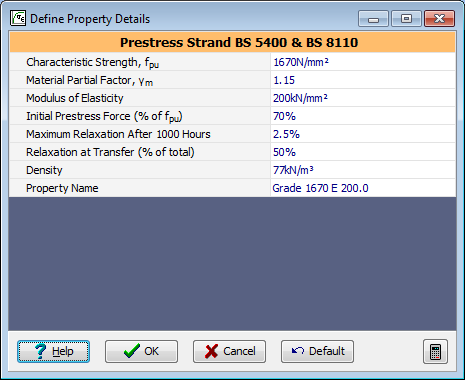Prestressing Steel Properties
Description
Definition of the material properties for a section or beam is a three step process:
- Add the material type (concrete / reinforcing steel / etc.)
- Define a set of properties for that material type (characteristic strength etc.)
- Allocate the material properties defined in 1 and 2 to the relevant parts of the section or beam section component.
This form performs the second of these 3 stages for prestressing strand. As data is entered the program checks that values are within the expected range for steel. This check will highlight any values in error by a factor of 10 more. The displays for Ultimate Limit State and Serviceability Limit State are to the same scale, and are updated as the values in the fields are changed.
The data for initial prestress force, and relaxation is used only in the beam analysis parts of the program.
Form Graphic

Field Help
Characteristic strength fpu
Enter the characteristic strength of the prestress tendons. A warning will be issued if the value entered is unrealistic, but the value will not be rejected. update to EN 10138-3.
Material partial factor γm
Enter the partial safety factor for strength. Values not between 1 and 2 will be rejected.
BS 5400 Part 4 specifies 1.15 in clause 4.3.3.3.
BS 8110 Part 1 specifies 1.05 in Table 2.2.
CS 455 Table 2.13a specifies:
1.15 for use with the characteristic strength,
1.10 for use with the worst credible strength.
Modulus of Elasticity
Enter the modulus of elasticity of the prestress tendons. The default value is 200kN/mm2 which is the value given by BS 5400 Part 4 figure 3 for wire and strand to BS 5896.
Other values that might be appropriate are as follows:
- for BS 5400 Part 4 and CS 455: 165kN/mm2 for alloy bars to BS 4486
- for CS 455: 165kN/mm2 19-wire strand to BS 4757 section 3; 175kN/mm2 for 19-wire strand to BS 4757 section 2
Note that values in BS 8110 Part 1 figure 2.3 differ.
Initial Prestress force
Enter the prestress force immediately after anchoring as a percentage of the characteristic strength. The default value is 70%.
BS 5400 Part 4 clause 6.7.1 allows 70% for Post_tensioned tendons or 75% for pre-tensioned tendons.
Note that despite the 75% limit allowed in BS 5400, some beam manufacturers are reluctant to stress beyond 70% for drawn strand, or for large numbers of strand. The Prestressed Concrete Association currently recommends 70%.
Note that for deflected tendons consideration should be given to the possible influence of the size of the deflector on the strength of the tendons. (clause 6.7.1)
Max Relaxation after 1000 hours
Enter the value of maximum relaxation after 1000 hours as a percentage of the initial prestress force.
The value to be used depends upon the relaxation properties of the steel and the amount of the initial load. BS 5896: 2012 Table 13 gives suitable values.
The default value is 2.5% for the BS 5400 / BS 8110 property, and 8% for the CS 455 property. 2.5% is the value for low relaxation strand initially loaded to 70% of the characteristic strength, and 8% is the value for normal relaxation strand initially loaded to 70% of the characteristic strength.
Relaxation at transfer
Enter the value of relaxation at transfer as a percentage of the total (1000 hour) relaxation. Note that for Post_tensioned concrete the value should be entered as zero in accordance with clause 6.7.2.2 of BS 5400 Part 4.
For pre-tensioned concrete, a value of 50% is often assumed. This value is adopted as the default.
Density
Enter the density of the Prestressing Tendon.
Property name
The program will supply a reference name which provides an identifier to the material property set which is usually unique. This value may be edited to give a more readily recognisable name if required.
